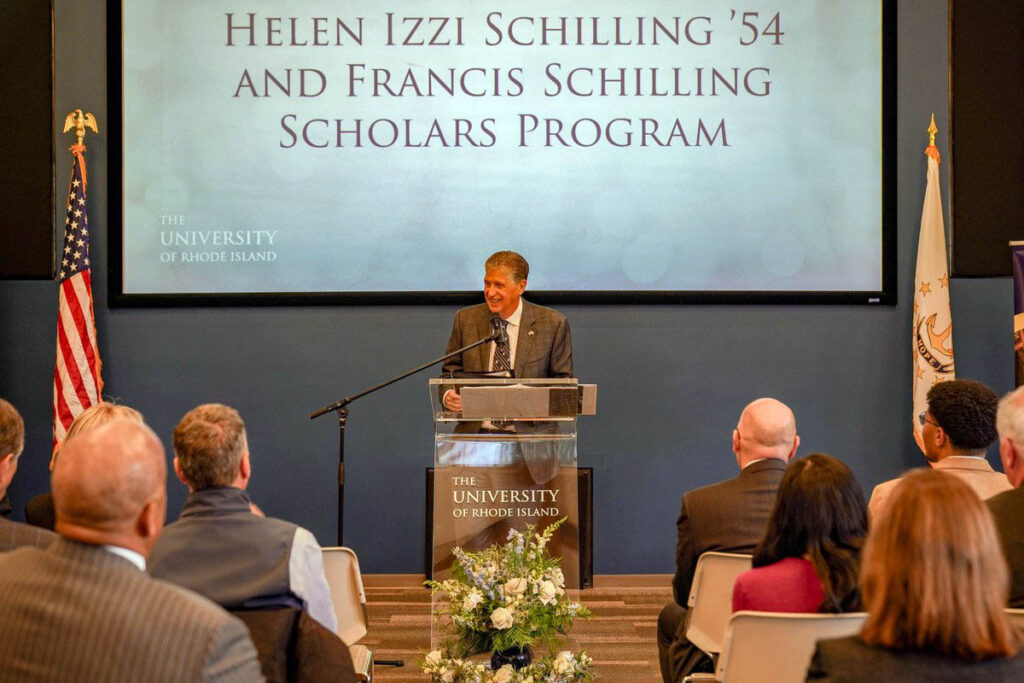2024 International students locations from the Office of Institutional Research | Graphic Credit: Abbie Chipps, News Editor
International student enrollment at the University of Rhode Island remains low compared to enrollment 10 years prior, as faculty prepares for the potential further strain from another Trump administration.
URI’s international enrollment currently makes up 2.8% of the student population, according to data from the Office of Institutional Research. The university’s international makeup is under half of the U.S. average, which was 6% as of November of 2024, according to the Institute of International Education.
In 2015, URI saw a record number of international students at 569, making up 3.3% of the total student population. These numbers came after former President Barack Obama expanded programs to support undocumented and international students in 2014, according to Inside Higher Ed.
International enrollment dropped again after the election of President Donald Trump into his first term, with a 17% decrease in undergraduate enrollment for international students at URI between 2015 and 2016.
Melissa De Jesus, director of international students and scholars and immigration services at URI since 2011, attributed that loss primarily to fewer students from China studying abroad since the first Trump administration.
From 2012 to 2020, China held the spot for most international students at URI, according to data from the OIR. 2013 saw the highest percentage, with Chinese students making up 41% of all international students.
While international enrollment has started to climb since the COVID-19 pandemic, reaching 495 students in 2024, the highest number since 2019, administrators and professors are worried about what another Trump administration could mean for international students and education.
Lars Erickson, a professor of French and the director of the French branch of the international engineering program, is one of the faculty that helps to facilitate URI students going abroad and international students studying in Rhode Island.
“I’m a little bit more concerned about [international] students no longer wanting to come to the U.S., that would really end our exchange agreements,” Erickson said.
The program also includes a fifth year abroad, where students spend the first semester at a university in a country with their chosen language and a second semester as an engineering intern in that same country. Languages include Spanish, Italian, Japanese, German, French and Chinese, according to Erickson.
The university has exchange agreements with other universities in those countries, allowing students from those countries to study at URI for a year and for URI to send their students abroad, according to Erickson.
If the foreign institutions decide to stop sending international students to the United States, then programs like the IEP would no longer be able to run, according to Erickson.
Erickson worries that an end to these programs would potentially deprive students of the benefits of a globalized campus.
“Intercultural competence that students develop is probably the most valuable thing,” Erickson said. “Understanding that things work differently in a different country, and that people from a different country have slightly different perspectives.”
While enrollment numbers have yet to return to pre-pandemic and pre-Trump administration numbers, the portfolio of international students continues to diversify.
In 2024, the university saw the highest number of countries represented in 20 years, with 495 students hailing from 68 different countries, according to data provided by the OIR.
While India and China remain as two of the most common countries for international students historically, more students from South America, Africa and Western Europe were enrolled in 2024. Iran also saw a record number of students in 2024, with 38 enrolled, and the second most popular country.
Iran was previously targeted by the first Trump administration in 2017 along with seven Muslim countries. While these students would still be able to come to the U.S. through student visas, they could be “subject to enhanced screening and vetting requirements,” according to a presidential proclamation in September of 2017.
At the time of the executive order, URI had 21 students from Iran enrolled. By end of the first Trump administration, the university saw a 62% decrease in Iranian students, with only eight enrolled in 2020, according to the OIR’s data.
The current Trump administration has also drafted 43 countries as a part of a new travel ban, as of March 14, according to The New York Times.
These countries were divided into red, orange and yellow categories. With red countries having all travel banned, orange countries having visas “sharply restricted” and yellow countries having 60 days to address concerns.
URI has students from multiple countries falling into both red and categories of the drafted ban. Red countries include Iran, which currently holds the second highest international enrollment at URI, making up 8.6% of international students, and Cuba which currently has two students at the university.
“Those [countries] are the ones really concerned about,” De Jesus said. “We’re trying to stay alert, and trying to get more information to try to advise properly to different students.”
Pakistan and Sierra Leone are two of the countries targeted under the orange category that currently have students at URI. Pakistan currently has six students, while Sierra Leone has one.
With these travel bans pending, the international office is attempting to keep students updated on potential issues through email alerts, while also not overwhelming them.
“We’re trying to be very cautious in the information we provide,” De Jesus said. “We also don’t want to alarm, and with no need.”
While the Trump administration has consistently targeted immigrants in both of the president’s terms, international students continue to contribute to U.S. universities and the economy.
In 2024, international students made up roughly 6% of college students in the U.S. and provided $43.8 million in economic benefit, both record highs, according to the National Association of International Educators.
In Rhode Island, just under 5,000 international students currently contribute $279.9 million to the economy, according to NAFSA. URI makes up $17.5 million, the third-highest contribution behind Brown University and Rhode Island School of Design.
“We want to be able to have a global community that we can learn from each other, and that’s welcoming,” De Jesus said.




